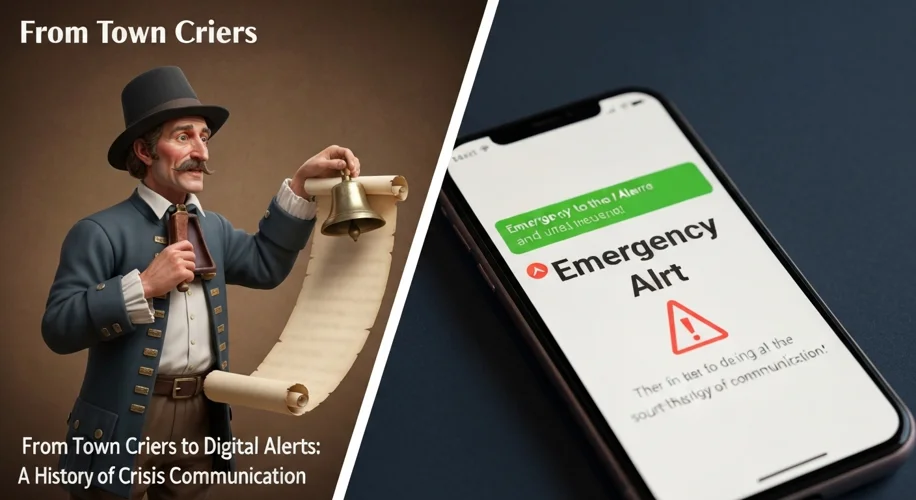In the hushed halls of academia, a crisis can erupt with terrifying speed, shattering the illusion of tranquil learning. Today, we peer back through the mists of time to trace how institutions, particularly universities, have grappled with the daunting task of communicating during emergencies, a journey that has transformed from rudimentary warnings to sophisticated, multi-channel alert systems.
For centuries, the primary means of disseminating urgent news relied on the human voice. Imagine a medieval university town: a sudden outbreak of plague, a looming invasion, or a devastating fire would be announced by the resonant calls of a town crier, his bell a stark punctuation mark against the prevailing quiet. These individuals were the first alert systems, their immediate presence and powerful lungs the only conduits for vital information. While effective for localized events, this method was inherently limited. A distant campus, a sprawling city, or a widespread disaster would render the town crier’s efforts futile.

The advent of the printing press offered a more scalable solution, but the logistical challenges of mass printing and distribution meant that timely communication during rapidly unfolding crises remained a significant hurdle. Newspapers and broadsheets could inform the public after the fact, but they were ill-suited for immediate emergency alerts. Universities, often centers of intellectual thought and burgeoning student populations, found themselves ill-equipped to respond with the speed and reach demanded by escalating threats.
The 20th century brought a paradigm shift with the widespread adoption of electricity and telecommunications. Early warning systems, often tied to military or civil defense efforts, began to emerge. Think of air raid sirens during World War II, a chilling testament to the existential threats that spurred the development of more robust communication infrastructure. Universities, too, started to develop rudimentary internal alert systems, often involving campus police or administrative offices making phone calls to key personnel. The goal was to mobilize resources and inform critical staff, but the reach was still largely confined to landlines and direct contact.
The digital age, however, would revolutionize crisis communication. The late 20th and early 21st centuries witnessed an explosion in the types and capabilities of alert systems. The proliferation of personal computers and the internet laid the groundwork for digital messaging. Universities began experimenting with email lists and early campus-wide notification systems. The Y2K scare, while ultimately a non-event, served as a wake-up call, prompting many institutions to invest in more resilient technological infrastructure, including communication networks.
The defining moment for modern emergency preparedness and communication, however, arrived with the widespread adoption of mobile phones and the development of sophisticated mass notification platforms. Events like the Virginia Tech shooting in 2007 starkly illuminated the critical need for rapid, multi-modal communication. The university’s initial communication methods were too slow and fragmented, leading to delayed warnings and increased casualties. This tragedy became a watershed moment, spurring a national conversation and significant investment in emergency alert technologies.

Universities began to implement comprehensive systems capable of broadcasting alerts through multiple channels simultaneously: text messages, emails, website banners, social media, digital signage, and even automated phone calls. The philosophy shifted from simply informing to actively engaging and protecting the campus community. Protocols were developed, drills were conducted, and the understanding of crisis communication evolved from a reactive measure to a proactive, integral component of institutional safety.
Yet, challenges persist. Ensuring the accuracy and reliability of information in the fog of a crisis, combating misinformation that spreads like wildfire on social media, and reaching every individual within a diverse and often dispersed community remain formidable tasks. The speed at which threats can materialize today – from active shooters to severe weather events – demands constant vigilance and adaptation.
The evolution of crisis communication in academic settings mirrors the broader societal shifts in how we share information. It’s a story of technological innovation driven by necessity, a testament to our enduring need to protect and inform. From the solitary town crier to the complex digital network, the journey has been long, marked by moments of failure and triumph, all aimed at ensuring that when danger strikes, the message of safety is heard, loud and clear, by all.
As we look to the future, the integration of artificial intelligence, the refinement of early detection systems, and the ongoing effort to foster a culture of preparedness will continue to shape how universities and other institutions navigate the unpredictable landscape of emergencies. The echoes of past crises serve as a constant reminder of the vital importance of effective communication, a silent guardian in times of uncertainty.

